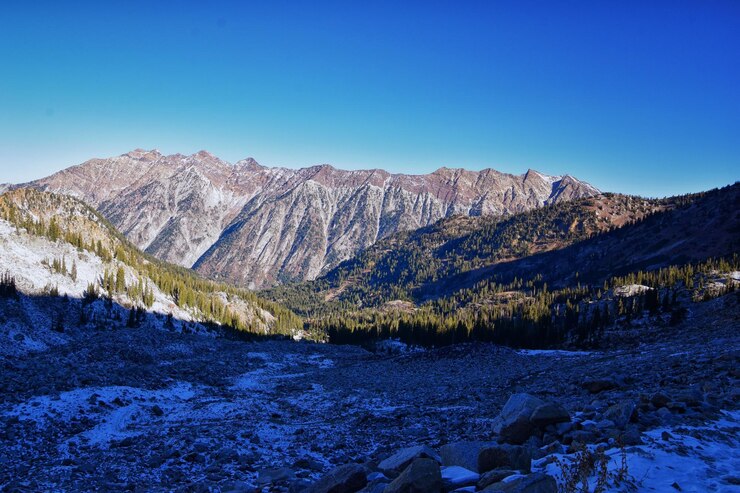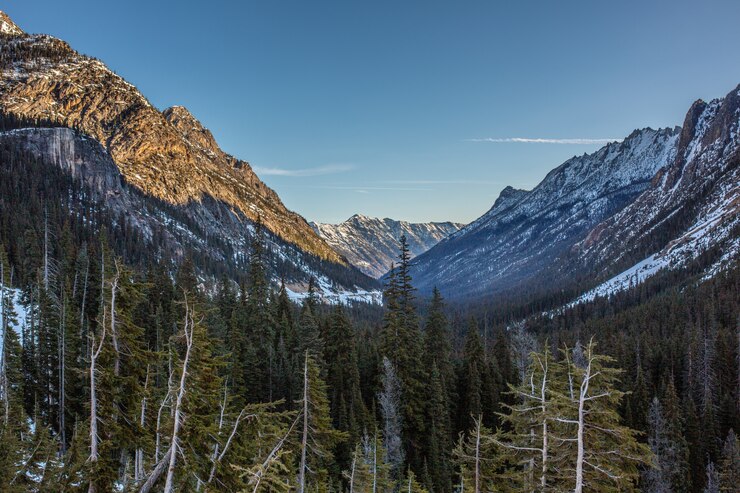Mountain valleys are nature’s masterpieces, cradling diverse ecosystems, rich cultural histories, and breathtaking landscapes. For those looking to escape the hustle and bustle of city life, these serene enclaves offer a perfect retreat. This blog post will explore the allure and beauty of mountain valleys, taking you on a journey through their unique environmental features, historical significance, personal stories, travel tips, and the importance of environmental conservation.
The Allure and Beauty of Mountain Valleys
Imagine waking up to the crisp, fresh air of a mountain valley, surrounded by towering peaks and lush greenery. The serene environment, punctuated by the soft rustling of leaves and the gentle flow of rivers, offers a calming escape from the chaos of everyday life. Mountain valleys are not just scenic wonders; they are havens of biodiversity and tranquility.
The natural beauty of mountain valleys captivates the senses. From the vibrant wildflowers that bloom in spring to the vibrant foliage of autumn, every season paints a different picture. These valleys provide a sanctuary for wildlife, with animals like deer, foxes, and various bird species calling them home. For those who appreciate the finer details of nature, mountain valleys are a treasure trove of wonders waiting to be explored.
Unique Environmental Features
Mountain valleys boast unique environmental features that set them apart from other landscapes. The diverse flora and fauna are a testament to the ecological richness of these regions. Alpine plants, adapted to high altitudes, thrive in the cooler temperatures, while the lower slopes are adorned with deciduous and coniferous trees.
The geological formations in mountain valleys are equally fascinating. Glacial valleys, carved by the slow movement of glaciers, create U-shaped depressions that offer dramatic vistas. River valleys, on the other hand, are formed by the continuous erosion of flowing water, resulting in V-shaped landscapes. These geological processes not only shape the physical appearance of the valleys but also influence the types of ecosystems that develop within them.
The microclimates within mountain valleys contribute to their ecological diversity. The varying altitudes and slopes create different temperature and moisture conditions, allowing a wide range of plant and animal species to coexist. For nature enthusiasts and researchers, mountain valleys are a living laboratory for studying ecological interactions and adaptations.
Historical Significance
Mountain valleys have played a vital role in shaping the history and culture of various civilizations. Throughout history, these regions have served as natural barriers, protecting communities from invasions and preserving unique cultural identities. Mountain valleys have also been cradles of human settlement, providing fertile lands and abundant resources.
In many cultures, mountain valleys hold spiritual significance. They are often considered sacred places where people seek solace and connect with nature. Traditional festivals, rituals, and customs are deeply intertwined with the natural rhythms of the valleys. These cultural practices have been passed down through generations, enriching the local heritage.
Economically, mountain valleys have been hubs of agricultural activity. The fertile soil and favorable climate make them ideal for cultivating crops such as grains, fruits, and vegetables. The terraced fields that adorn many mountain slopes are a testament to the ingenuity of ancient farming techniques. Today, these valleys continue to support local economies through tourism and sustainable agriculture.
Personal Stories and Travel Experiences
Every mountain valley has its own stories to tell, shaped by the experiences of locals and visitors. Personal anecdotes and travel experiences offer a glimpse into the magic of these natural wonders. From thrilling hiking adventures to tranquil moments of reflection, the memories created in mountain valleys are cherished for a lifetime.
Visitors to mountain valleys often share tales of discovering hidden gems. Whether it’s a secluded waterfall, a charming village, or a panoramic viewpoint, these lesser-known destinations add an element of surprise to the journey. The sense of exploration and discovery makes every trip to a mountain valley unique and memorable.
Local residents, too, have their own stories to share. Their deep connection to the land and its traditions adds a layer of authenticity to the travel experience. Engaging with locals provides valuable insights into the history, culture, and daily life of mountain valley communities. It fosters a sense of appreciation and respect for the people who call these valleys home.
Tips for Planning a Trip
Planning a trip to a mountain valley requires careful consideration of several factors. Seasonal variations play a significant role in determining the best time to visit. Spring and summer are ideal for outdoor activities such as hiking, camping, and wildlife spotting. Autumn offers stunning foliage, while winter transforms the valleys into a snowy wonderland perfect for skiing and snowboarding.
Packing for a mountain valley adventure requires some thought. Layered clothing is essential to adapt to changing temperatures, and sturdy hiking boots are a must for exploring rugged terrains. Don’t forget essentials like sunscreen, insect repellent, and a first-aid kit. Depending on the activities you plan to undertake, you may also need specialized gear such as trekking poles or fishing equipment.

When it comes to activities, mountain valleys offer a plethora of options. Hiking trails cater to all levels of fitness and experience, from gentle walks to challenging ascents. Camping under the stars provides a unique opportunity to immerse yourself in nature. Birdwatching, fishing, and photography are other popular pursuits. Be sure to research the specific offerings of the valley you plan to visit to make the most of your trip.
Environmental Conservation
Preserving the pristine beauty of mountain valleys requires collective effort. Environmental conservation initiatives aim to protect these fragile ecosystems from the impacts of human activity. Visitors can contribute to these efforts by adopting responsible travel practices and supporting local conservation projects.
One of the key principles of responsible travel is minimizing your ecological footprint. This includes practices such as leaving no trace, reducing waste, and respecting wildlife habitats. Staying on designated trails and using eco-friendly products can significantly reduce your impact on the environment. Supporting local businesses that prioritize sustainability further contributes to the preservation of the valleys.
Many mountain valleys have established conservation programs that focus on protecting endangered species, restoring natural habitats, and promoting sustainable tourism. By participating in these programs, visitors can play an active role in safeguarding the future of these natural wonders. Volunteering for clean-up drives, donating to conservation funds, and spreading awareness are just a few ways to get involved.
Conclusion
Mountain valleys are more than just picturesque landscapes; they are dynamic ecosystems that support diverse life forms and hold cultural significance. Exploring these valleys offers a unique opportunity to connect with nature, learn about different cultures, and create lasting memories. By planning your trip thoughtfully and practicing responsible travel, you can ensure that these natural wonders continue to thrive for future generations.




